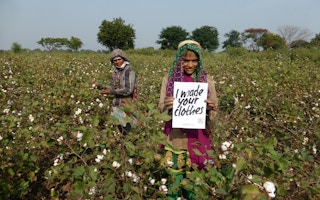This week, a global consumer campaign aims to raise awareness of the forgotten people of the fashion industry.
To continue reading, subscribe to Eco‑Business.
There's something for everyone. We offer a range of subscription plans.
- Access our stories and receive our Insights Weekly newsletter with the free EB Member plan.
- Unlock unlimited access to our content and archive with EB Circle.
- Publish your content with EB Premium.
“Who made my clothes?” is the rallying cry behind the Fashion Revolution Week campaign that launched on April 24 to mark the fourth anniversary of the Rana Plaza collapse in Bangladesh in 2013, which killed and injured thousands of garment workers.
The tragedy highlighted the exploitation of garment workers who toil to make the world’s top apparel brands. It was the catalyst for the founding of Fashion Revolution by an activist group of the same name and, more broadly, a wake-up call for the fashion industry.
Visitors can expect panel discussions, film screenings, clothing swaps and upcycling workshops with the goal of highlighting supply chain abuses and inspiring consumer action in the week ahead in more than 90 countries.
The movement began as an one-day event in 2015 with participants taking to social media and email to ask brands, “Who made my clothes?”. The hashtag #whomademyclothes was created to drive wider understanding of human rights issues in fashion and urge more brands to take action.
Speaking to Eco-Business a day before the launch of this year’s event in Singapore, Laura Francois, country coordinator for Fashion Revolution Singapore said the platform - which is being held in the city-state for the second time - is a “wake-up call” for Singaporean shoppers.
Although Southeast Asia is home to a large part of the fashion production cycle, awareness of issues such as worker exploitation remains low in Singapore, Francois pointed out.
Garment workers in Cambodia, for instance, only receive about half of the daily required calorie intake and one-third are underweight, while labourers in Bangladesh earn as little as US$68 a month.
Noting that Singapore is not a major apparel producer, Francois commented: “It’s easier to connect with an issue when you get to see both sides, but Singapore is in a little bit of a bubble.”
“There’s a disconnect between the reality (of what’s happening in the region) and the crazy shopping habits of Singaporeans,” she said.
According to a recent Channel NewsAsia survey, Singaporeans buy an average of 34 pieces of clothing a year and throw out 27, while local charity The Salvation Army receives about six tonnes of discarded clothing daily.
However, with active shopping habits comes consumer power, and Francois said she believes Singapore’s shoppers can have an impact in making the fashion industry commit to more sustainable practices.
Fashion Revolution has been extended into a week-long programme for its third edition. A total of 22 countries in Asia and the Middle East will host Fashion Revolution Week, from major clothes producers Bangladesh, India and Cambodia, to shopping meccas Japan and South Korea.
In Singapore, events include a documentary screening of The True Cost, which highlights labour abuses and pollution in fashion supply chains as well as upcycling workshops, and panel discussions about sustainable fashion.
Last year’s campaign featured 1,400 global events and online initiatives, and over 2,600 #imadeyourclothes posts on Twitter and Instagram from clothing producers, garment workers and makers.
The campaign, particularly the #whomademyclothes Twitter hashtag, has prompted a response from some fashion brands, Francois noted.
“That culminated in what is called the Fashion Transparency Index. We publish an index of brands that have come out in response to the campaign and reveal their supply chain indices,” Francois said.
She added that being transparent does not have to mean brands disclosing the names of every factory worker. “But if they come out and tell us the names of their factories and where they are located, that’s a huge step,” she said.
“We’re not trying to police them to become fully transparent immediately, because a lot of brands don’t even know where their stuff is being produced, and it takes a lot of work on their end to figure it out.”
At a consumer level, Francois said she has seen a lot of activity such as clothes swaps as a result of Fashion Revolution campaigns in Malaysia, where she was country coordinator until last year. The popularity of clothes swaps in Singapore has also grown through outfits such as Swapaholics.
Each participating Fashion Revolution country has its own goals. The plan in Singapore is to use this year’s event as a litmus test to see how the group can reach out to consumers more effectively, and collaborate with industry players such as Singapore Fashion Week.
Asked what the average person can do right now to support sustainable fashion and change in the industry, Francois recommended thinking twice before buying new clothes according to the ‘Rule of 30’.
She explained: “If you can promise yourself you will wear that piece of clothing 30 times, sure. Otherwise it’s probably not a good idea.”
“This rule is an incredible money saver too,” she said.










